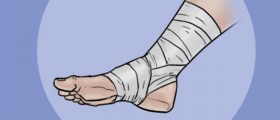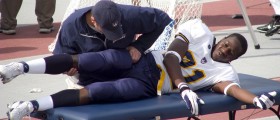
Strained calf muscle is a type of injury and is basically caused by overstretching of the calf muscle. There is usually a different degree of the tear of the affected muscle and the injury is typically accompanied by the sudden onset of pain and several more symptoms such as swelling and in severe cases bruising. The injured people may face difficulties while standing and they are not capable of walking due to intensive pain. Calf muscle strains are graded into three levels depending of the severity of the injury and structural damage to the muscle.
Levels of Calf Muscle Strains
As previously mentioned the severity of the injury classifies calf muscle strains into three levels.
In the grade one the injury of the calf muscle leads to cramping, the feeling of tightness and pain. Structural changes in the muscle are in a form of 'micro tears' of the muscle fibers. The recovery does not last long, approximately 15 days.
The grade two of calf muscle strains typically features with tenderness of the injured area and the pain is much more intensive than in the grade one. Tears of the muscle fibers are larger than in the grade one but they are partial. The recovery time after this injury lasts from 5 to 6 weeks.
And finally, in the grade three of the injury the patients are not able to walk and any kind of movement comes with severe pain. This grade also features with the presence of a lump in the injured area. The tear completely affects muscle fibers and since the injury is much more complex than the previous two the person recovers for several months. This type of injury basically requires surgical repair.
Treatment for Strained Calf Muscle
As in any similar injury the golden rule called RICE is applied. RICE is short for rest, ice, compression and elevation. The first thing an injured person is supposed to do is to apply ice packs or cold compresses onto the injured area. They will reduce the swelling and alleviate the pain to a certain extent. Cold compresses or ice packs are due to be applied for 15 minutes several times a day. Furthermore, the injured calf is wrapped with a compression bandage. This maneuver additionally reduces swelling. The injured leg must be placed in elevated position. Rest is essential for proper healing of the damaged muscle fibers. The patients are commonly prescribed anti-inflammatory medications. Their role is to relieve the pain. The doctor decides when the patients can return to regular daily activities and for how long they are supposed to abstain from exercises and similar strenuous activities.

















Your thoughts on this
Loading...